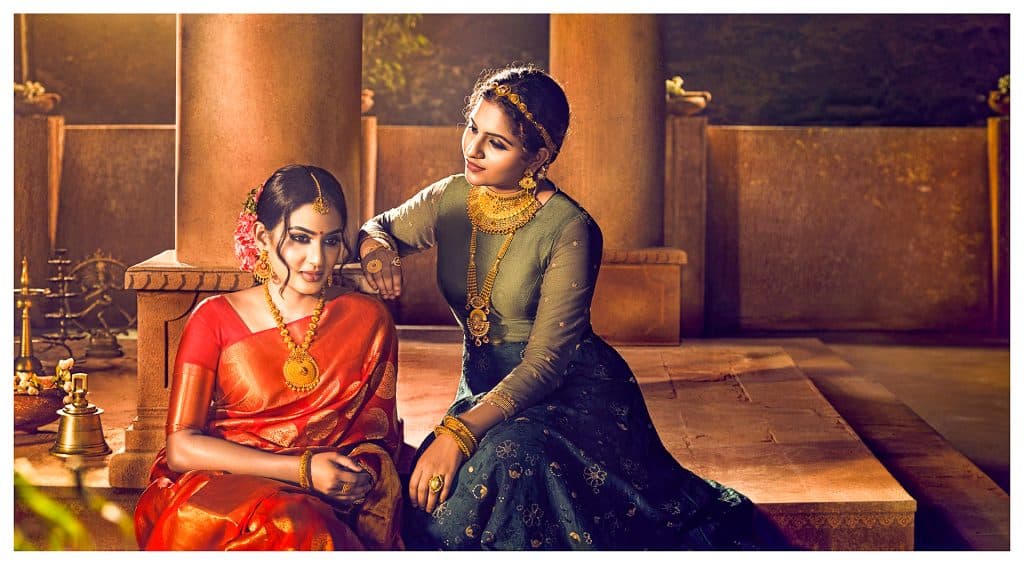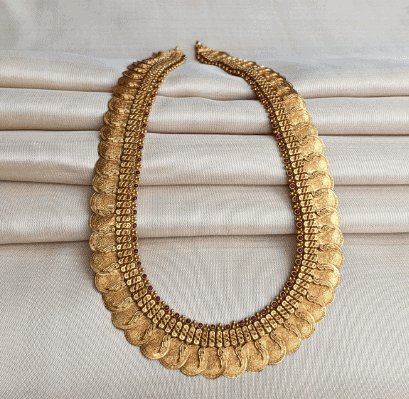Handcrafted with love and passed down through generations, traditional Karnataka jewellery is a treasure of prosperity, pride, and identity.

Karnataka’s traditional jewellery is not just beautiful; it’s a symbol of the region’s long history and creativity. Known for detailed designs that never go out of style, Karnataka’s jewellery includes everything from the grand ‘Mangalorean Bunt’ necklaces to the pretty ‘Kasu Malai’ chains. Each of these traditional gold jewellery designs tells a story from the past, showing what’s important to the culture.
These pieces are made using old methods that have been taught from one generation to the next. They represent wealth, pride, and who people are in Karnataka, far beyond being mere accessories. This jewellery captures the heart of traditional Indian jewellery and highlights the skill of local artists, making it special for both those who know a lot about jewellery and those who are just starting to learn in Bengaluru Karnataka’s rich centres of jewellery making/.
For example, a bride from the Mangalore Bunt community treasures her gold jewellery set, which includes various necklaces and ‘balais’ (bangles). These items are carefully made with designs that take inspiration from nature and include symbols that are meant to bring good luck to the bride as she starts a new part of her life.
Here’s a look at the jewellery that celebrates Karnataka’s traditions:
Kasina Sara and Misri Mala
The Kasina Sara is a necklace made from coins, and the Misiri Mala is a similar coin necklace but with a stamp or embossing of Lakshmi on it. This type of necklace is a staple in South Indian jewellery collections and goes by different names in various states. In Andhra Pradesh and Telangana, it’s called Kasulaperu; in Tamil Nadu, it’s known as Kasumalai; and in Kerala, people refer to it as Kasumala.

Havalakki Sara
The Havalakki Sara, also known as Avalakki Sara, is a traditional South Indian necklace designed to resemble flattened rice or poha. It’s a popular piece of wedding jewellery among brides in South Karnataka. This necklace is not just famous in Karnataka but also in other states. In Maharashtra, it’s referred to as Poha Haar, and in Kerala, it goes by the name Avilmala. It’s a cherished part of traditional jewellery collections, especially for Kannadiga brides.
Mallige sara/Mallimoggu Sara
The Mallige Sara, also called Mallimoggu Sara, is a necklace designed to look like jasmine buds. It can be made of plain gold or decorated with precious stones such as rubies, emeralds, and diamonds. In Kerala, this necklace is known as Mullamottu Mala.
Lakshmi Sara
The Lakshmi Sara is a special necklace that brides in Karnataka wear to represent and seek the blessings of Goddess Lakshmi for their new life. It comes in different styles, including a Lakshmi choker, a long Lakshmi haaram, and a Lakshmi Kasina Sara. This necklace is a key piece in a traditional Karnataka bridal collection. In other states, it’s known by names like Lakshmi Mala, Lakshmi Malai, and Lakshmi Haar.
Kokkethathi Necklace
Kokkethathi is a traditional bridal necklace, featuring a pendant shaped like a half-moon, worn by Coorgi or Kodava brides. This distinct necklace, also known as Kokkethathi, is deeply embedded in the rich and ritualistic traditions of Coorgi jewellery, making it a popular choice among brides from other Kannadiga communities as well.
Pavan Sara
The Pavan Sara is a necklace made up of coin-shaped trinkets arranged in a specific pattern. This style of necklace is also well-liked in Kerala, where it’s known as Panamala. Nowadays, there are many modern designs and arrangements, but the traditional Pavan Sara remains a favourite among Kannadiga brides and women.
Gilola Sara
Gili Ole refers to earrings adorned with rubies and pearls, arranged to depict parrots, complemented by three jhumka (bell-shaped) danglers. Matching these earrings, the Gilola Sara is a necklace richly embellished with precious stones and pearls, also fashioned in the shape of parrots.
This distinctive set of necklaces and earrings captures the essence of traditional Karnataka culture. In Kannada, ‘Gili’ translates to ‘parrot,’ and ‘Ole’ signifies ‘danglers,’ making Gili Ole synonymous with parrot danglers.
Tholu Bandhi
Tholu Bandhi is an ornate forearm bracelet cherished by Karnataka women and traditionally worn on special occasions. This exquisite piece features a central peacock motif, often accompanied by figures of gods, enhancing its spiritual and aesthetic appeal.
Extending from both ends of the central design, chains lead to a secure locking mechanism, ensuring a snug and comfortable fit. Its intricate craftsmanship and symbolic design make it a staple of ceremonial attire.
Entele Sara
The Entele Sara is a precious piece of heritage jewellery that holds a special place in the hearts of brides from South Karnataka, especially among those belonging to the Tuluva, Bunt, or Mangalorean communities. This beautiful necklace is designed with several layers of gold chains, giving it a rich and elegant look.
It’s a symbol of tradition and is cherished on special occasions like weddings. In the northern parts of India, a necklace with a similar layered design is known as a Rani Haar, which translates to “queen’s necklace,” highlighting its regal charm.
Kokkethathi
Kokkethathi, characterized by its unique half-moon-shaped pendant that hangs on a necklace, is a traditional piece of bridal jewellery cherished by Coorgi or Kodava brides. Known by the same name, Kokkethathi, this necklace embodies the rich and ritualistic traditions of Coorgi jewellery design, making it a sought-after choice among brides from other Kannadiga communities as well.
Kukkumidi Sara
The Kukkumudi Sara is a quintessential piece of traditional Karnataka jewellery, revered for its unique design and cultural significance. This exquisite necklace is crafted with intricate detailing, often featuring a blend of vibrant colours and motifs that reflect the rich heritage of the region. Symbolizing beauty and tradition, the Kukkumudi Sara is a cherished adornment among women, especially during festive occasions and weddings, adding a touch of elegance and tradition to their attire.
Muthina Vole Jhimiki
The Muthina Vole Jhimiki is an emblematic traditional piece of Karnataka jewellery, distinguished by its elaborate craftsmanship. These are ornate earrings made with pearls (muthu means pearl in Kannada), often embellished with gold and precious stones to create intricate designs. Symbolic of elegance and sophistication, the Muthina Vole Jhimiki is a favoured accessory for women in Karnataka, adorning their ears during weddings, festivals, and other auspicious occasions, showcasing the region’s rich cultural heritage.
Karthamani Pathak
The Karthamani Pathak stands as a testament to the rich cultural tapestry of Karnataka, embodying the traditional jewellery craftsmanship of the region. This venerable piece, often worn around the waist, is meticulously crafted from gold and adorned with intricate designs and precious stones. Serving both as a symbol of marital status and a piece of ceremonial adornment, the Karthamani Pathak is cherished by women, especially during significant events like weddings and religious ceremonies.
Jadaenagara
Jadaenagara is a traditional piece of Karnataka jewellery that plays a crucial role in the bridal ensemble. This ornamental hair accessory is designed to adorn the braids of brides, adding a majestic touch to their overall appearance. Crafted with gold and often embellished with colourful gemstones, Jadaenagara reflects the craftsmanship and cultural heritage of Karnataka. It symbolizes beauty and grace, making it an essential element of the bridal trousseau in Karnataka weddings.
Guruvina Kada
Guruvina Kada is a bracelet that holds deep cultural significance. Crafted with precision and care, this gold bangle is often intricately designed, featuring symbols and motifs that pay homage to spiritual and natural elements. It’s not just a piece of jewellery; it’s a wearable symbol of respect and devotion, reflecting the rich traditions and values of Karnataka. Worn by both men and women, Guruvina Kada is a cherished emblem of heritage and faith.
Kasina Bale
Kasina Bale is renowned for its elegant and timeless design. These are gold bangles that embody the essence of Karnataka’s rich cultural heritage, often intricately crafted with exquisite patterns and sometimes studded with precious stones. Kasina Bale is a symbol of prosperity and grace, worn by women as a mark of their cultural identity and during important life events, making it a treasured adornment in Karnataka’s traditional attire.
Mooguthi
This gold nose piece comes in various designs, from understated studs to ornate versions decorated with gems. More than just a decorative item, Mooguthi signifies femininity and, often, marital status, making it a cherished symbol across generations of women. It holds a special place in their traditional wardrobe, reflecting their heritage and identity.
Padasara
Typically worn around the ankles, this ornamental piece beautifully captures the essence of Karnataka’s rich cultural heritage through its intricate gold craftsmanship. Designed to chime melodically with every step, Padasara is not only a symbol of elegance and grace but also an auditory delight, adding a rhythmic beauty to the wearer’s presence. It’s a cherished accessory, especially during festive and ceremonial occasions.
These timeless pieces, from elegant bangles to intricate nose rings, not only adorn but also celebrate Karnataka’s traditions, making them cherished heirlooms that connect generations and embody the spirit of its people.
Read more: Latest



